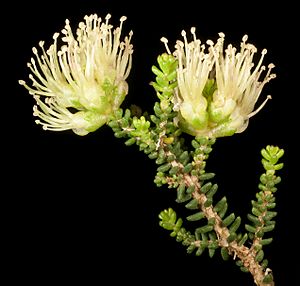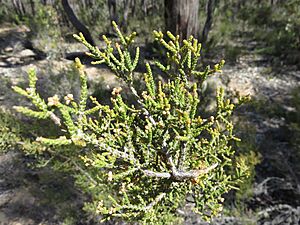Wattle honey-myrtle facts for kids
Quick facts for kids Wattle honey-myrtle |
|
|---|---|
 |
|
| Conservation status | |
| Scientific classification | |
| Genus: |
Melaleuca
|
| Species: |
micromera
|
The Melaleuca micromera, also known as the wattle honey-myrtle, is a special plant from the myrtle family. It grows only in a small part of Western Australia. This plant is quite rare. It has unusual leaves and many small yellow flowers. Because it's so unique, people sometimes grow it to help protect it from disappearing.
Contents
What Does Wattle Honey-Myrtle Look Like?
The wattle honey-myrtle is a shrub that grows upright. It can reach about 3 metres (10 feet) tall and wide. Its branches are often twisted, giving it a unique look.
Its Tiny Leaves
The leaves of this plant are very small. They grow in groups of three around the stem. Each leaf is pressed close to the stem. They are only about 0.9 to 1.5 millimetres (0.04 to 0.06 inches) long. They are also thick for their size. If you look closely, you might see tiny oil dots on them.
Its Yellow Flowers
The flowers grow in small clusters at the ends of the branches. Each cluster is about 10 millimetres (0.4 inches) across. They can have between 3 and 18 individual flowers. The petals are small and fall off as the flower gets older. The stamens, which are the parts that hold pollen, are yellow. They are arranged in five groups around the flower.
When the plant is in bloom, its small yellow flowers can make it look like a wattle plant from a distance. It usually flowers in early spring, sometimes as early as July. After flowering, it produces small, woody, cup-shaped fruits. These fruits are about 2.5 to 3 millimetres (0.10 to 0.12 inches) long and wide. They grow in small groups along the stem.
How It Got Its Name
This plant was first officially described in 1844. A scientist named Johannes Conrad Schauer gave it its scientific name, Melaleuca micromera.
Meaning of "Micromera"
The second part of its name, micromera, comes from two Ancient Greek words. "Mikros" means "small," and "meros" means "part." This name was chosen because of the plant's very tiny leaves.
Where Wattle Honey-Myrtle Grows
The wattle honey-myrtle only grows in a few specific areas in the south-west of Western Australia. You can find it in places like Mount Barker, the Stirling Range, and the Green Range districts. It likes to grow in clay or sandy gravel soils.
Why This Plant Is Important
The government of Western Australia lists Melaleuca micromera as "Priority Three". This means it's a poorly known species. It's found in several locations, but it doesn't seem to be in immediate danger of disappearing. However, it's still important to protect it.
Growing Wattle Honey-Myrtle
This plant is interesting to grow because of its tiny leaves and twisted branches. Its colourful flower heads also make it attractive. It grows well in gardens and can be planted in rockeries or large pots. Giving it a light trim each year helps it stay healthy.



